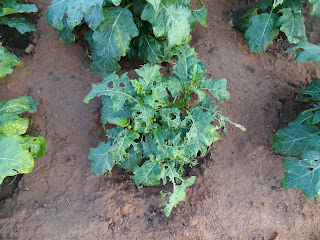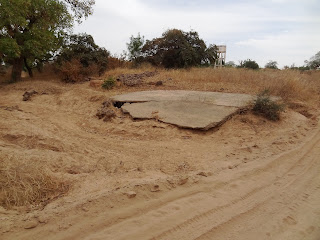I am currently between jobs and have decided to take some
time to explore agriculture in Ghana, West Africa. I am staying just outside of
the capital Accra, which lies along the southern coast. Accra is well developed
by African standards, as electricity is common as are plumbing and flush
toilets.
Recently, I went to visit family relatives of my host here
in Accra.
Life in the bush is still very much a work in progress. The
area where I went to visit, in the south central region of Ghana is very much like
bush villages in Guinea. The one distinguishing feature is the presence of
electricity, kindly provided by a well made investment in a hydroelectric dam
from Lake Volta. Other striking differences are the lack of donkeys and horses
for transport, as well as roaming goats and sheep. The area is extremely lush
and green, and definitely a tropical zone.
 |
| The bush village I recently visited. |
Primary cash crops include plantain,
cassava, palm oil, and cocoa. In fact, the area is a hotbed for cocoa
production.
 |
| Villagers cracking cocoa pods |
 |
| Village boys with their drying cocoa. |
Thankfully, food security is generally not a problem. People
have enough to eat all year round. What they don’t have is money to develop
their lives and villages.
Looking around, it can be hard to pin down exactly what’s
holding back this region back economically. Unlike the places I’ve worked in
Guinea and Senegal, this region does not suffer from the extreme environmental
degradation that other parts of Africa have to contend with. In fact, one
morning I went for a walk in one of the nearby national forests, which is very
well protected and managed by the government and citizens alike.
Other than recommending the adoption of more sustainable
agriculture techniques such as intercropping and organic pest control, there
was not much I could immediately recommend that I felt would make a significant
long term impact.
That was,
until the day I left.
Earlier in the week, I had asked the local village chief,
the uncle of my host in Accra, if he had a deed to his property.
He said he had.
I asked if he would mind showing it to me. I was just
curious to check out a theory some professor had made in a book I had recently
read, called, The Mystery of Capital,
by Hernando DeSoto.
He said of course.
So on my last day in the village, he brought out a two page
document detailing the legal arrangements for “his” land.
What I saw made my heart sink!
The piece of paper that this man felt gave him ownership of
his homestead and farmland was nothing more than a rental agreement, between
his family (the tenant) and another company (the landlord).
And the terms of this agreement are so onerous that they
border on modern day slavery!
The most onerous of these conditions is the price for which
this family is paying for the privilege to farm this piece of land:
30% of the total harvest
of cocoa.
Yes, you read that right,
30 percent their cocoa revenues disappears into their
landlord’s pockets.
INTO PERPETUITY!!!
(There is no closing date on this lease.)
 |
| The document stipulating the terms of their servitude. |
For those not familiar with business, this thirty percent is
a serious chunk of money, no matter what country you are operating in. So
serious that I doubt that many businesses could even survive with a parasite
like this attached to their business.
In return, the families in this village, as well as in many
other small villages in the area, are allowed to live here.
And the company has NEVER made any contribution to the
development of the village.
No School. No medical center. No infrastructure or capital
improvements.
NADA. NOTHING. ZILCH.
(The dirt road and electricity have been provided by the
national government. The local primary school is privately owned, and families
struggle to pay the school fees.)
This is the way it has been for this village since 1971.
Yes, for the last 45 years, this village has been a slave to
this arrangement.
You might say, it’s the fault of the villagers for agreeing
to such an arrangement.
Kind of like a white man coming to an African village in
1790 and offering a job and a life of prosperity to the chief’s son, only to
never see him (or his “wealth”) again because he has been hauled away on a
slave ship to America where he is the property of a white cotton farmer in the
southeastern United States.
You might be inclined to say to let sleeping dogs lie. It
has been this way for 45 years, so its not going to change. Why bother? ‘
Why rock the boat and disturb this
Peaceful and romantic
life in the African bush that so many Americans hoist upon the struggling and exploited
African peasant farmer?
Why?
Because I hope that there is something in all of us that is
worth fighting for,
that is
worth dying for.
Because poverty is not always about lack of economic growth.
It often is about
Deprivation
And the corrosive effects that deprivation has on
empowerment.
Without personal empowerment and changes to the very social
structure in which people live, efforts to alleviate poverty through economic
growth will always fall short.
Sustainably and
permanently reversing poverty so that everyone can claim a fair and equitable
share of economic growth requires continual efforts to build, strengthen and
expand empowerment!
Why must this be continual?
Because the forces
that cause disempowerment are continual.
Not only those that directly cause disempowerment, but those
that cause disempowerment through lack of attention or a misplaced toleration
of unacceptable predicaments of our fellow human beings.
Building personal empowerment goes hand in hand with
reducing exploitation.
As Amartya Sen says in the preface to From Poverty to Power, active citizenship can be a very effective
way of finding solutions to pervasive problems of powerlessness and unfreedom. These
efforts can make a huge difference in fighting intolerable and unacceptable
deprivations.
So I need your help (NOTE I did not say your money… at least
not yet.)
I need help telling this story. To bring it to life, not
only in words, but in pictures and sound.
A documentary spotlighting the trap that these Ghanian
farmers find themselves would be an ideal vehicle to bring a voice to these
people. First, to document their fight to secure fair and just property rights
for land that they have called home for nearly 50 years. Second, to provide a
template and hope for others in their fight to secure legal title to the land
they call home.
So what can YOU do to help?
WHO do you know who has expertise in this area? I am only 6
degrees from an activist filmmaker like Roger Moore… CONNECT ME!
WHO do you know who can provide legal help to these peasants
to secure clear legal title to their lands? CONNECT ME!
WHO do you know who has social media experience that can
help tell this story? CONNECT ME!
WHO do you know in the not for profit sector who is working
in Ghana with whom I can partner with?
CONNECT ME!
Until then, I am working with local Ghanian friends to see explore other ways to change this unfair dynamic.















